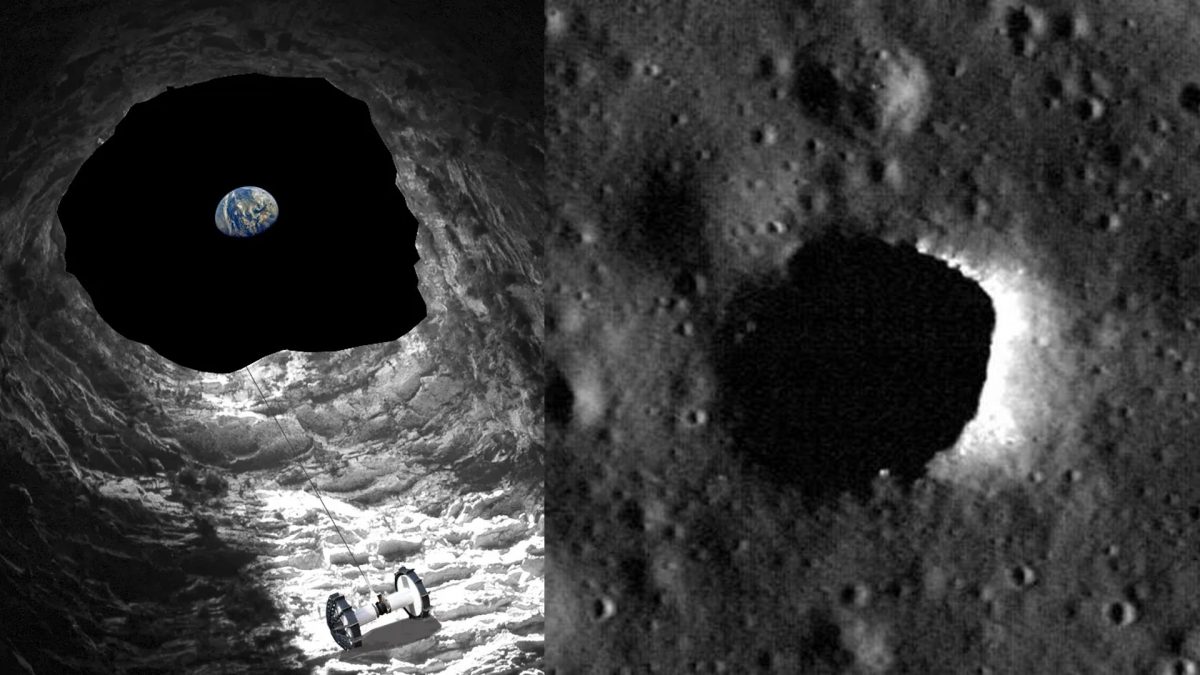NASA’s lunar reconnaissance orbiter (LRO) has provided radar data revealing that the Mare Tranquillitatis pit, the deepest known on the moon, leads to a cave that is 45 meters wide and up to 80 meters long. This cave is located about 150 meters beneath the lunar surface read more
)
These caves offer several benefits for potential moonbases or emergency shelters. The temperature inside remains relatively stable, and they provide natural protection from cosmic rays, solar radiation, and micrometeorites. Image Credit: Space.com, NASA
Researchers have discovered a significant underground cave on the moon, accessible from the surface, which could become a prime location for a future lunar base. This cave can be reached through an open pit in the Mare Tranquillitatis (Sea of Tranquility), where Apollo 11 astronauts Neil Armstrong and Buzz Aldrin first landed over fifty years ago.
NASA’s lunar reconnaissance orbiter (LRO) has provided radar data revealing that the Mare Tranquillitatis pit, the deepest known on the moon, leads to a cave that is 45 meters wide and up to 80 meters long, equivalent to 14 tennis courts. This cave is located about 150 meters beneath the lunar surface.
Lorenzo Bruzzone from the University of Trento in Italy has indicated that the cave is likely an empty lava tube, which could serve as a natural shelter against the moon’s harsh environment, making it a suitable habitat for future explorers. Lava tubes are large underground tunnels formed by volcanic activity, and they have been of interest since lunar orbiters first spotted pits on the moon more than a decade ago. Many of these pits are believed to be skylights connecting to such lava tubes.
These caves offer several benefits for potential moonbases or emergency shelters. The temperature inside remains relatively stable, and they provide natural protection from cosmic rays, solar radiation, and micrometeorites. Previous LRO images showed the Mare Tranquillitatis pit’s bottom covered with boulders up to 10 meters wide. However, it was uncertain whether the pit was a standalone structure or an entrance to an underground cave.
Detailed in Nature Astronomy, scientists used LRO data and computer simulations to confirm that the 100-meter-wide pit, with vertical or overhanging walls, leads to a sloping floor and a cave extending tens of meters westwards. Studying the rocks inside such caves is of great interest as they might hold clues about the moon’s formation and volcanic history. These caves may also contain water ice, crucial for long-term lunar missions and colonization.
At least 200 pits have been identified on the moon, many on lava fields that could be entrances to vast subterranean lava tubes. These caves offer significant advantages, providing the main structural components for a human base without requiring extensive construction efforts, as noted by Leonardo Carrer, the study’s first author.
As preparations for humans returning to the moon continue, space agencies are considering how to assess the structural stability of these caves and how to reinforce their walls and ceilings. Monitoring systems to detect movement or seismic activity and designated safe areas for astronauts will be necessary precautions.
Lunar cave systems are seen as ideal sites for future crewed bases due to their protective rock ceilings, shielding people and infrastructure from the extreme lunar surface temperature variations and high-energy radiation. However, much is still unknown about the underground structures below these pit entrances.
One of the main challenges, according to Robert Wagner from Arizona State University, is accessing these pits. Descending 125 meters to reach the cave floor involves navigating steep slopes of loose debris, posing risks of avalanches. While it is feasible to enter and exit, it will require significant infrastructure to ensure safety.

 2 months ago
12
2 months ago
12
)
)
)
)
)
)
)
)
)
)
)
)
)
)
)
)
)
)
)
)
)
)
)
)
 English (US) ·
English (US) ·